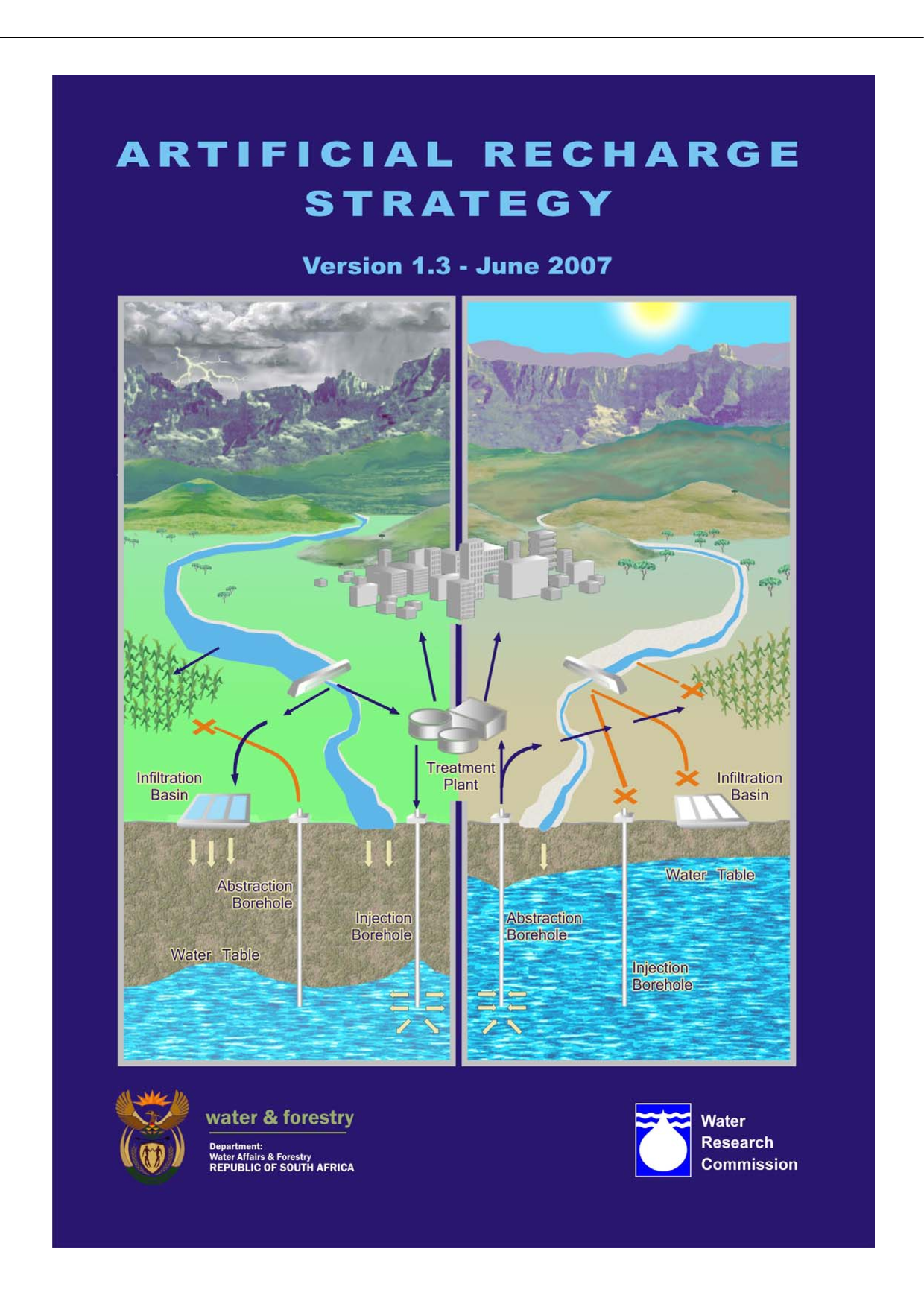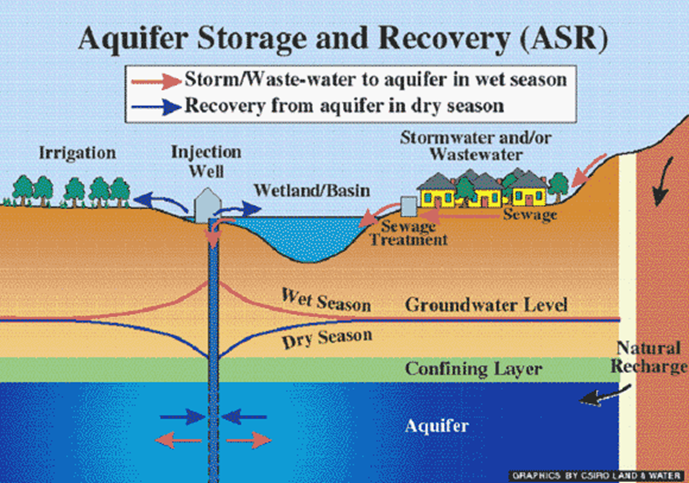Background
Unlike surface water, volumes of usable groundwater are more difficult to estimate. As a result, people tend to use groundwater at a vastly more unsustainable rate than they use surface water [2]. In addition, surface waters are recharged constantly whereas much groundwater is “fossil” water that accumulated in the past when climate conditions were very different than today. After decades of over production of groundwater in many regions, water reserves have been depleted to the point that it is no longer economically feasible to produce more water and/or the aquifer is no longer viable. Specifically in arid regions such as the Middle East or the American Southwest [3] where fossil groundwater is a major resource that is threatened by overuse and little recharge, artificial recharge is a plausible solution to groundwater depletion [1]. There are two main approaches to water storage: 1) large reservoirs created by damming rivers and 2) artificial recharge of unconfined and confined aquifers.
Artificial Recharge
Many shallow aquifers “recharge” naturally from precipitation and infiltration from rivers and streams. However, in arid regions where fossil water is being exploited there is little natural recharge. Artificial recharge involves returning surface runoff as well as treated water back to the aquifer to allow reuse. There are two major kinds of artificial recharge:
Direct Surface Recharge Technique: this is the process by which waste water or water from extreme weather events is diverted into ponds or tanks and allowed to slowly percolate back into shallow unconfined aquifers through overlying soils and rocks; this is also a natural filtering process. The effectiveness of this method is controlled by the surface area across which the water is spread and the permeability of the rock the water must pass through [1][4].
Direct Subsurface Recharge Technique: also known as direct injection, this technique requires use of injection wells so that water can be returned to deep, confined aquifers. The limitations of this technique are the costs [5] for drilling and maintenance and operation of the injection facility. This much more expensive alternative compared to surface recharge [1].
Figure 1: The direct surface recharge technique wherein water percolates down through the rocks to the water table [9].
Surface recharge only works with relatively shallow unconfined aquifers whereas injection recharge is for aquifers bounded by impermeable layers that prevent surface water from reaching the aquifer under the force of gravity. However, different combinations of these two methods may be used to optimize recharge rates [1][7].
Artificial recharge has economic benefits as well. Whereas reservoirs behind dams are often considered an excellent way to store water, in many cases artificial recharge of groundwater aquifers offers a better solution from both economic and environmental perspectives. Major dams are expensive to construct (upwards of $2 billion) and involve diversion of rivers and flooding of landscapes. Artificial recharge stations that pump water from rivers do not divert a significant amount of the total flow and would cost a small fraction of what it would to build a dam (around $150 million) [5]. Moreover, the reservoirs that result from dam construction flood river valleys and greatly perturb riverine ecosystems. In addition, many dams are built in arid areas where evaporative loss from large lakes is very significant (lake mead, for example, loses 88 million cubic meters a year to evaporation) [8].
One of the most efficient ways of implementing artificial recharge is by using treated wastewater to recharge aquifers. In Polokwane, South Africa, artificial recharge has been a technique used by the city for the past 30 years. Their method of artificial recharge, which has supplied their city with an additional 4 million cubic meters of water annually, is based on allowing treated sewage to fill recharge basins where the water slowly percolates downwards recharging the aquifer [4]. The benefits of this system include not having to use more groundwater than is recharged making an otherwise unsustainable resource sustainable and not having to divert as much water from rivers permitting downstream users to benefit.
Figure 2: How water can be stored underground during the wet season and then drawn up again during the dry season [10].
The simplicity and relatively low cost of artificial recharge cannot be stressed enough. Artificial recharge involves both recycling of treated sewage as well as subsurface “banking” of water during the wet seasons for use during the dry season. This approach can be practiced by nearly every country regardless of its GDP and without huge centralized dams. Specifically, areas that have already developed centralized water distribution systems and wastewater treatment systems but are undergoing water stress (i.e. the American Southwest or Australia) could easily divert the treated waste water to a infiltration basins to replenish aquifers. However, in less developed regions that are unable to distribute water or treat waste water but need a way to store water for the dry season, artificial recharge can also be a viable solution. For example artificial recharge could be as simple as setting aside several acres of land and building mud walls around the area to collect runoff during the rainy seasons. This water can then percolate back into the ground providing more water in the dry season.
Not only would further usage of artificial recharge allow groundwater to become a renewable resource, but it is also provides a cheaper, faster, and less technologically intensive method of storing water in large quantities. For these reasons, artificial recharge is a necessary strategy that will help solve the water crisis.
Implementation
Artificial recharge can be implemented virtually anywhere that has surface water or over 500 mm of rainfall a year. Though building a recharge site requires funding, the price will vary with the scale. For example, building a recharge site for a small village will be a lot cheaper than building a recharge plant for a metropolitan area. Mission 2017 has decided to approach the implementation of artificial recharge through the use of an application process for nations that interested in reaping the benefits of recharge. When a nation applies it will have to share information regarding the regional water scarcity of its nation as well as the layout of any centralized water distribution systems it has (part 1). Upon disclosing this information, Mission 2017 will be able to, on a case by case basis, analyze which part of the country would best benefit from the usage of artificial recharge. Such an examination will include studies of ground permeability and locating significant aquifers within the nations borders (part 2). From here Mission 2017 will follow its implementation procedures to derive the necessary funds, whether it be from businesses or banks, construct methods of artificial recharge (part 3). We believe that while the application process can be established and publicized within a 5 year period, it may take another 5-10 years to do the necessary preliminary research depending on the size of the country. As a result, it may be 15 to 20 years before the benefits of artificial recharge are obtain on a global scale (the additional 5 years is due to the actual construction of the artificial recharge mechanisms).
While this timeline seems tedious, it is important to remember that the solution process depends upon any given nations’ federal governments cooperation. Mission 2017 has also considered utilizing the support of Non-Governmental Organizations as well. For instance, we believe that NGOs would be able to spread information about artificial recharge and its simplicity much faster than a national government could. As a result, basic version of artificial recharge (like a village building building mud walls to capture rainfall) could be implemented on time scale of 3 to 5 years depending on the effectiveness of the NGO. Thus, artificial recharge my be able mitigate extremity of the water crisis over the next half a decade.
References
1.Das Gupta, Ashim. Artificial Recharge of Groundwater (2013). Retrieved from http://www.unep.or.jp/ietc/publications/techpublications/techpub-8e/artificial.asp
2.What Are Alternatives to Damming Rivers? (2013). Retrieved from http://www.americanrivers.org/initiatives/water-supply/dam-alternatives/
3. Pottinger, Lori. How Dams Affect Water Supply (2009). Retrieved from http://www.internationalrivers.org/resources/how-dams-affect-water-supply-1727
4.Mwansa, B. J. Artificial Recharge of Aquifers (1994). Retrieved from http://www.oas.org/dsd/publications/Unit/oea59e/ch18.htm
5.Management of Making Aquifer Recharge Better Use of and Subsurface Storage Our Largest Reservoir (2002). Retrieved from http://siteresources.worldbank.org/INTWRD/Resources/GWMATE_Final_booklet.pdf
6.Location of Case Studies of Artificial Recharge Projects (2004). Retrieved from http://www.artificialrecharge.co.za/casestudies/polokwane.pdf
7.Konrad, C.P. Assessment of Ground-Water Storage Through Artificial Recharge at Six Sites in the Methow River Basin, Washington. Retrieved from http://wa.water.usgs.gov/projects/methow/data/wa44702_text.pdf
8. U.S. Geological Survey. Scientific Investigations report (Jan 2013). Retrieved from http://pubs.usgs.gov/sir/2006/5252/section2.html
9. Ricky Murray, Gideon Tredoux, Phillip Ravenscroft, Fanie Botha. (29 June 2007). Artificial Recharge Strategy. Web. Retrieved on 2 Dec. 2013. http://www.docstoc.com/docs/74279308/Artificial-Recharge-Strategy-for-South-Africa_-June-2007
10. Robert Puls. (2013). Artificial Recharge/Aquifer Storage and Recovery. Web. Retrieved on 2 Dec. 2013. http://oklahomawatersurvey.org/?p=145


